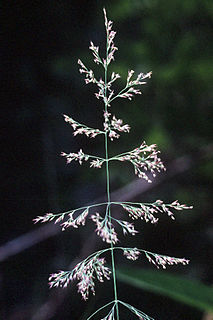
Calamagrostis is a genus of flowering plants in the grass family Poaceae, with about 260 species that occur mainly in temperate regions of the globe. Towards equatorial latitudes, species of Calamagrostis generally occur at higher elevations. These tufted perennials usually have hairless narrow leaves. The ligules are usually blunt. The inflorescence forms a panicle. Some may be reed-like.

Panicum (panicgrass) is a large genus of about 450 species of grasses native throughout the tropical regions of the world, with a few species extending into the northern temperate zone. They are often large, annual or perennial grasses, growing to 1–3 m tall.

Bouteloua curtipendula, commonly known as sideoats grama, is a perennial, short prairie grass that is native throughout the temperate and tropical Western Hemisphere, from Canada south to Argentina.

Acacia ligulata is a species of Acacia, a dense shrub widespread in all states of mainland Australia. It is not considered rare or endangered.

Antennaria dioica is a Eurasian and North American species of flowering plant in the family Asteraceae. It is a perennial herb found in cool northern and mountainous regions of Europe and northern Asia, and also in North America in Alaska only.

Parthenocissus inserta, also known as thicket creeper, false Virginia creeper, woodbine, or grape woodbine, is a woody vine native to North America, in southeastern Canada and a large area of the United States, from Maine west to Montana and south to New Jersey and Missouri in the east, and Texas to Arizona in the west. It is present in California, but it may be an introduced species that far west. It is introduced in Europe.
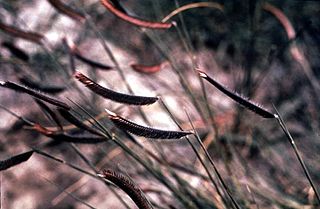
Bouteloua gracilis, the blue grama, is a long-lived, warm-season (C4) perennial grass, native to North America.

Bouteloua is a genus of plants in the grass family. Members of the genus are commonly known as grama grass.

Albert Spear Hitchcock was an American botanist and agrostologist.

Symphyotrichum lateriflorum is a species of flowering plant in the aster family (Asteraceae). Commonly known as calico aster, starved aster, and white woodland aster, it is native to eastern and central North America. It is a perennial and herbaceous plant that may reach heights up to 120 centimeters and widths up to 30 cm (1 ft).
Triniochloa is a genus of Latin American plants in the grass family.

Lasiacis (smallcane) is a genus of Neotropical plants in the grass family, found in the Americas from Mexico and Florida south to Argentina.
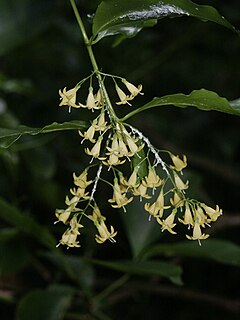
Chiococca alba is a species of flowering plant in the coffee family (Rubiaceae) native to Florida and the extreme southern tip of Texas in the United States, Bermuda, Mexico, Central America, the Caribbean, the Galápagos, and tropical South America. Common names include David's milkberry, West Indian milkberry, cahinca and West Indian snowberry. The specific epithet, alba, means "white" in Latin and refers to the color of its fruits.
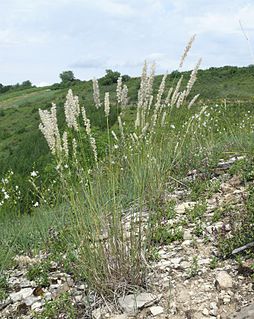
Melica ciliata, the hairy melic or silky spike melic, is a species of flowering plant in the grass family Poaceae, native to Europe, north Africa and temperate Asia. It has been introduced to South Australia.

Olearia suffruticosa, commonly known as clustered daisy-bush, is a species of flowering plant in the family Asteraceae and is endemic to south-eastern continental Australia. It is a shrub or undershrub with scattered, linear, grass-like leaves and pink to white and yellow and pink, daisy-like inflorescences.

Olyra latifolia, commonly known as carrycillo, is a species of bamboo in the grass family Poaceae. It occurs in Mexico, Central and South America, and in sub-Saharan Africa. It is a common species, up to 5 m (16 ft) tall, growing prolifically in rainforests, particularly near the margins.

Calyptocarpus vialis is a species of flowering plant in the family Asteraceae. Common names for C. vialis include straggler daisy, horseherb, lawnflower, and creeping Cinderella-weed. It is native to the southern United States, Mexico, Belize, Venezuela, and the Caribbean. It has also been introduced to Argentina, Hawaii, India, Java, Australia, and Taiwan. It is one of only three species in the genus Calyptocarpus.

Sphenopholis intermedia, the slender wedgegrass or slender wedgescale, is an annual grass native to North America. The specific epithet "intermedia" means "intermediate". The diploid number is 14.

Symphyotrichum potosinum is a species of flowering plant in the aster family (Asteraceae) native to Mexico and the U.S. state of Arizona. Commonly known as Santa Rita Mountain aster, it is a perennial, herbaceous plant that may reach 15 to 45 centimeters tall.
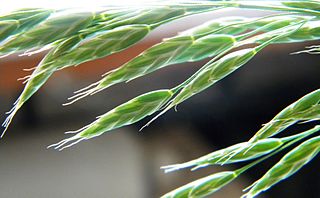
Bromus racemosus, the smooth brome or bald brome, is a species of flowering plant in the family Poaceae. It is native to subarctic and temperate Eurasia, and widely introduced elsewhere, including North America, Iceland, the Southern Cone of South America, the Korean Peninsula, Australia, and New Zealand. It grows in alkaline meadows and in waste places.



















